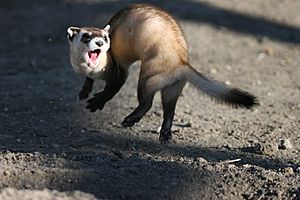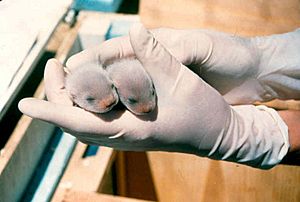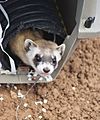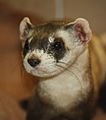Black-footed ferret facts for kids
Quick facts for kids Black-footed ferret |
|
|---|---|
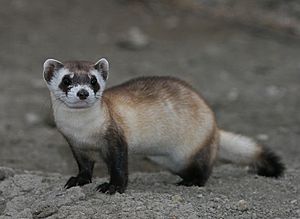 |
|
| Conservation status | |
| Scientific classification | |
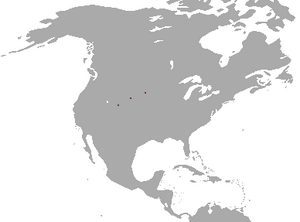 |
|
| Black-footed ferret range (three small areas on US territory) |
The black-footed ferret (Mustela nigripes), is a type of weasel. It is also called the American polecat or prairie dog hunter. It is native to central North America. It is an endangered species.
Predators of black-footed ferrets include golden eagles, great horned owls, coyotes, American badgers, bobcats, prairie falcons, ferruginous hawks, and prairie rattlesnakes.
Contents
History
Native American tribes, including the Crow, Blackfoot, Sioux, Cheyenne, and Pawnee, used black-footed ferrets for religious rites and for food. The species was not encountered during the Lewis and Clark Expedition, nor was it seen by Nuttall or Townsend, and it did not become known to modern science until it was first described in John James Audubon and John Bachman's Viviparous Quadrupeds of North America in 1851.
Description
The black-footed ferret has a long, slender body with black lines on the feet, ears, parts of the face and its tail. The neck is long and the legs are short. The toes have sharp claws. The top and bottom of the feet are covered with hair, even to the soles. The fur on its feet hides the claws.
Males are 500–533 millimetres (19.7–21.0 in) long. Females are usually 10% smaller than males. It weighs 650–1,400 grams (1.43–3.09 lb).
The base color is pale yellowish or buffy above and below. The top of the head and sometimes the neck is clouded by dark-tipped hairs. The face is crossed by a broad band of sooty black, which includes the eyes. The feet, lower parts of the legs, the tip of the tail and the preputial region are sooty-black. The area midway between the front and back legs is marked by a large patch of dark umber-brown, which fades into the buffy surrounding parts. A small spot occurs over each eye, with a narrow band behind the black mask. The sides of the head and the ears are dirty-white in color.
Behavior
The black-footed ferret is solitary, except when breeding or raising litters. It is nocturnal and primarily hunts for sleeping prairie dogs in their burrows. It is most active above ground from dusk to midnight and 4 am to mid-morning. Climate generally does not limit black-footed ferret activity, but it may remain inactive inside burrows for up to 6 days at a time during winter.
Prey density may account for movement distances. Black-footed ferrets may travel up to 11 miles (18 km) to seek prey.
Reproduction and development
Mating occurs in February and March. Litter size ranges from one to five kits. Kits are born in May and June in prairie dog burrows. Kits are raised by their mother for several months after birth. Kits first emerge above ground in July, at 6 weeks old. They are then separated into individual prairie dog burrows around their mother's burrow. Kits reach adult weight and become independent several months following birth, from late August to October. Sexual maturity occurs at the age of one year.
Diet
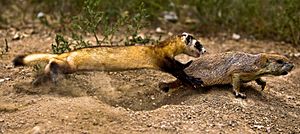
Up to 90% of the black-footed ferret's diet is composed of prairie dogs. The remaining 10% of their diet is composed of small rodents, and Lagomorphs. Their diet varies depending on geographic location.
Distribution and Habitat
Before, the black-footed ferret's range was from southern Alberta and southern Saskatchewan south to Texas, New Mexico, and Arizona. In 2007, the only known wild black-footed ferret population was found in the western Bighorn Basin near Meeteetse, Wyoming. Since 1990, black-footed ferrets have been reintroduced into the following places: Shirley Basin, Wyoming; UL Bend National Wildlife Refuge and Fort Belknap Indian Reservation, Montana; Conata Basin/Badlands, Buffalo Gap National Grassland, and the Cheyenne River Sioux Reservation in South Dakota; Aubrey Valley, Arizona; Rocky Mountain Arsenal National Wildlife Refuge and Wolf Creek in Colorado; Coyote Basin, and Grasslands National Park, Canada.
Before, the black-footed ferret lived in lots of habitats prairies with short grass, prairies with different types of grasses, desert grassland, shrub steppe, sagebrush steppe, mountain grassland, and semi-arid grassland. Black-footed ferrets use the burrows of prairie dog to raise their young ones, stay away from predators, and to keep themselves warm.
Interesting facts about the black-footed ferret
- In the year 2020, black-footed ferrets were used to test an experimental COVID-19 vaccine in Colorado.
- A study published in 1983 estimated that one adult female black-footed ferret and her litter require about 474 to 1,421 black-tailed prairie dogs per year or 412 to 1,236 white-tailed prairie dogs per year for sustenance.
- Employees of the San Diego Zoo, the conservation organization Revive & Restore, the ViaGen Pets and Equine Company and the U.S. Fish and Wildlife Service have teamed up to clone a black-footed ferret. In 2020, a team of scientists cloned a female named Willa, who died in the mid-1980s and left no living descendants. Her clone, a female named Elizabeth Ann, was born on December 10, 2020, making her the first North American endangered species to be cloned.
- Oil and natural gas exploration and extraction can have detrimental impacts on black-footed ferrets. Seismic activity collapses prairie dog burrows. Other problems include potential leaks and spills, increased roads and fences, increased vehicle traffic and human presence, and an increased number of raptor perching sites on power poles. Traps set for coyotes, American mink, and other animals may harm black-footed ferrets.
Images for kids
-
Black-footed ferret at the Louisville Zoo
-
Skeletons of black-footed ferret (left) and prairie dog (right) articulated to show the predator-prey relationship between the two. (Museum of Osteology)
See also
 In Spanish: Mustela nigripes para niños
In Spanish: Mustela nigripes para niños



